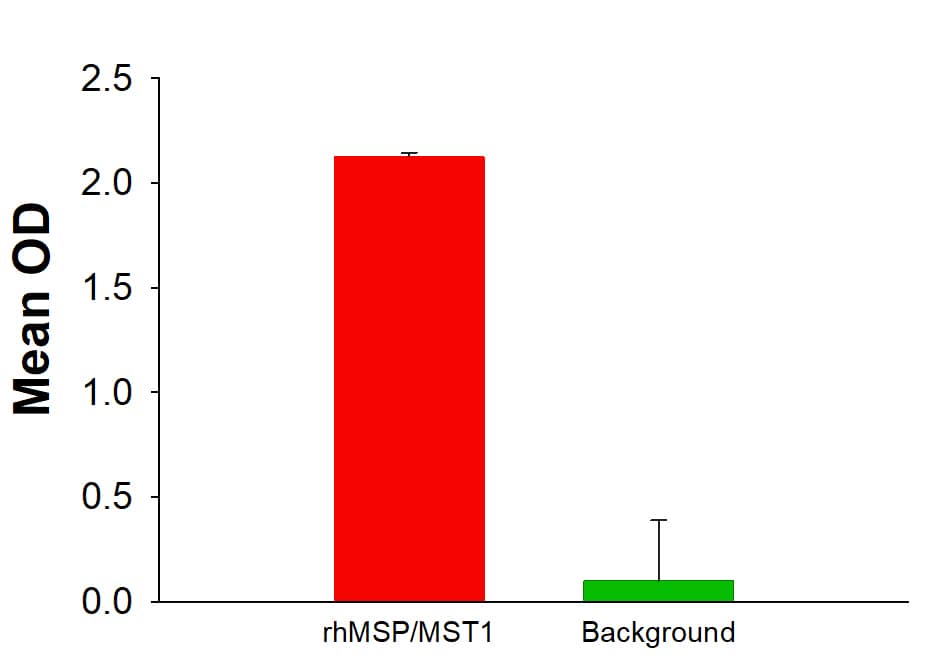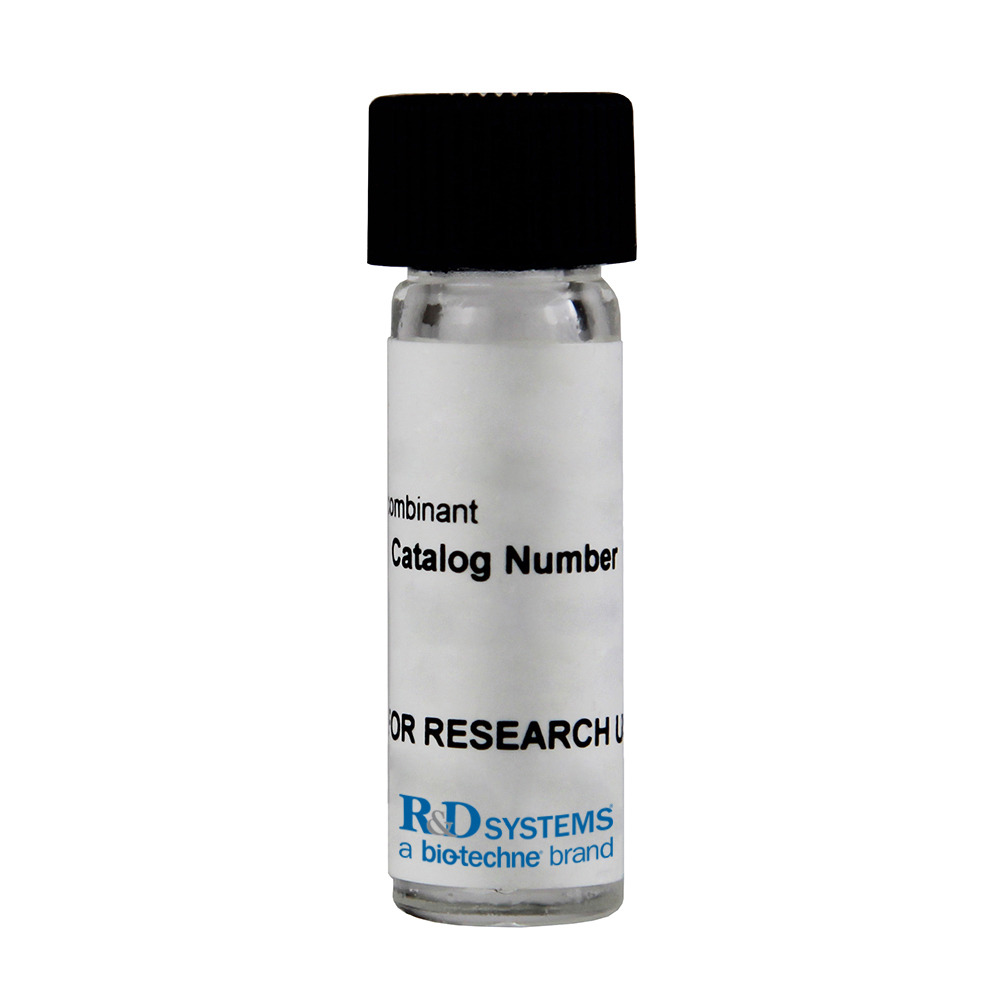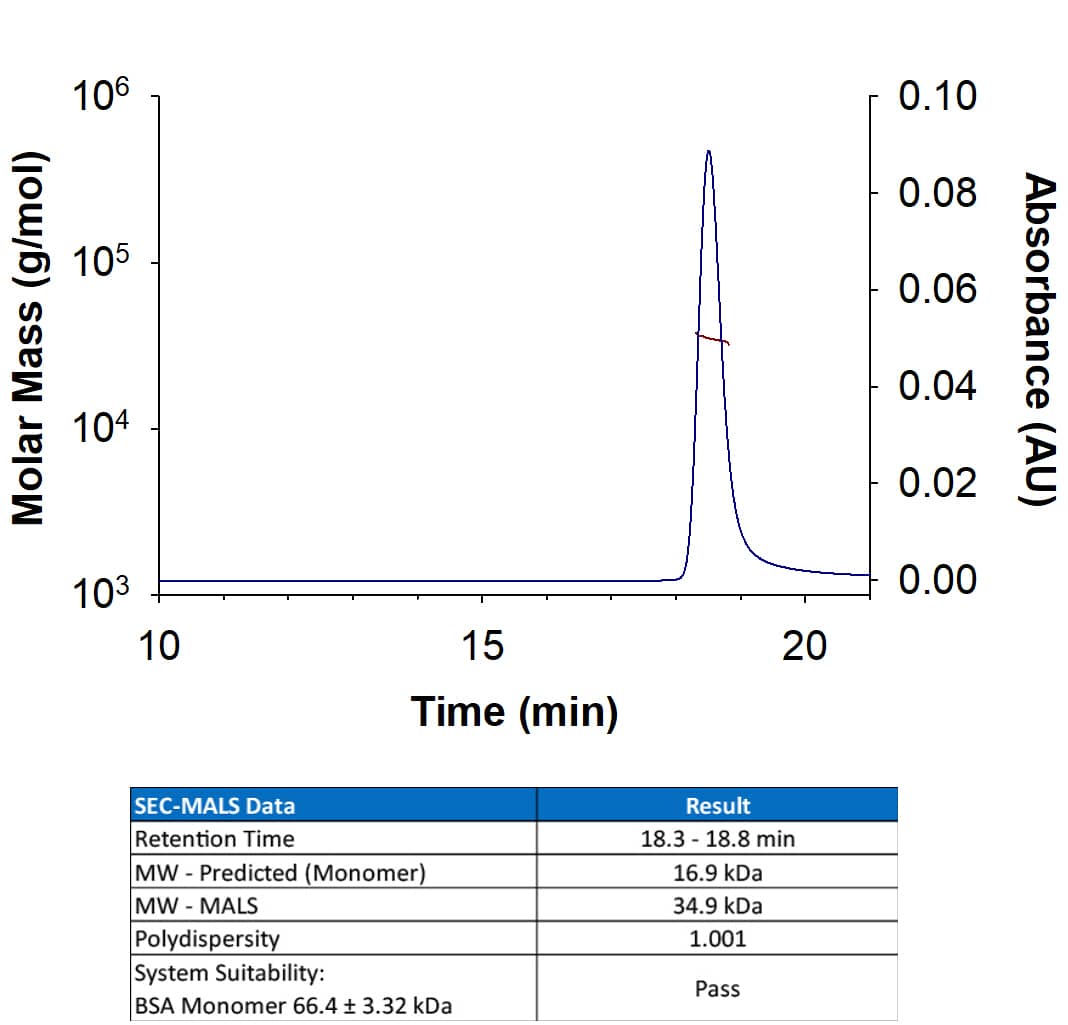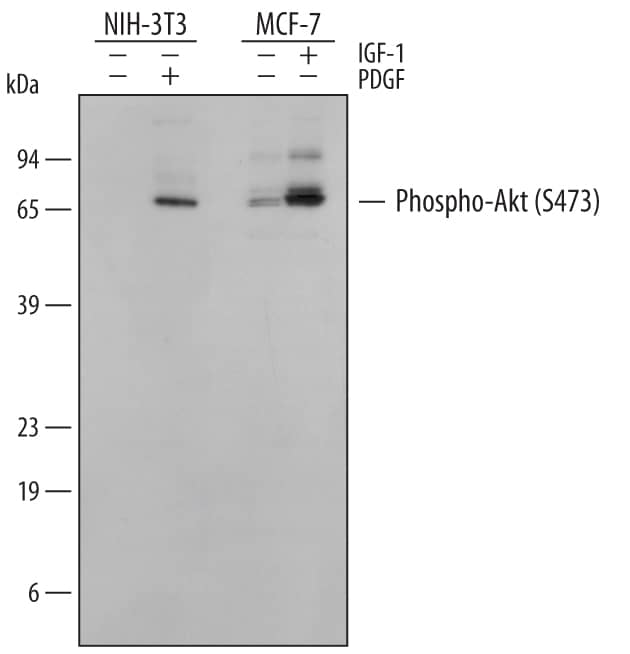Recombinant Human MSP/MST1 Protein Summary
Product Specifications
Recombinant Human MSP/MST1 (Catalog # 352-MS) binds to Recombinant Human MSPR/Ron Protein (Catalog # 1947-MS) with an ED50 of 8.00-40.0 ng/mL.
Gln19-Gly711
Analysis
Customers also Viewed
Product Datasheets
Carrier Free
CF stands for Carrier Free (CF). We typically add Bovine Serum Albumin (BSA) as a carrier protein to our recombinant proteins. Adding a carrier protein enhances protein stability, increases shelf-life, and allows the recombinant protein to be stored at a more dilute concentration. The carrier free version does not contain BSA.
In general, we advise purchasing the recombinant protein with BSA for use in cell or tissue culture, or as an ELISA standard. In contrast, the carrier free protein is recommended for applications, in which the presence of BSA could interfere.
352-MS
| Formulation | Lyophilized from a 0.2 μm filtered solution in PBS with BSA as a carrier protein. |
| Reconstitution | Reconstitute at 100 μg/mL in sterile PBS containing at least 0.1% human or bovine serum albumin. |
| Shipping | The product is shipped at ambient temperature. Upon receipt, store it immediately at the temperature recommended below. |
| Stability & Storage: | Use a manual defrost freezer and avoid repeated freeze-thaw cycles.
|
352-MS/CF
| Formulation | Lyophilized from a 0.2 μm filtered solution in PBS. |
| Reconstitution | Reconstitute at 100 μg/mL in sterile PBS. |
| Shipping | The product is shipped at ambient temperature. Upon receipt, store it immediately at the temperature recommended below. |
| Stability & Storage: | Use a manual defrost freezer and avoid repeated freeze-thaw cycles.
|
Scientific Data
 View Larger
View Larger
Recombinant Human MSP/MST1 Protein (Catalog # 352-MS) activates MSP R/Ron in MDA-MB-453 human breast cancer cells. Recombinant Human MSP/MST1 significantly induced phosphorylation of MSP R/Ron measured by DuoSet IC human phospho-MSP R/Ron kit (DYC1947).
Background: MSP/MST1
Macrophage stimulating protein (MSP), also known as HGF-like protein, and scatter factor-2, is a member of the HGF family of growth factors (1). MSP is secreted as an inactive single chain precursor (pro-MSP) that contains a PAN/APPLE-like domain, four kringle domains, and a peptidase S1 domain which lacks enzymatic activity (2). Human MSP shares 79% aa sequence identity with mouse MSP and 44% aa sequence identity with human HGF. Pro-MSP is secreted by hepatocytes under the positive and negative control of CBP in complex with either HNF-4 or RAR, respectively (3). Circulating pro-MSP is proteolytically cleaved in response to tissue injury to yield biologically active disulfide linked heterodimers consisting of a 45 - 62 kDa alpha and a 25-35 kDa beta chain (4, 5). Pro-MSP can be activated by MT-SP1, a transmembrane protease that is expressed on macrophages and is upregulated in many cancers (6). Heterodimeric MSP as well as the isolated beta chain bind to MSP R/Ron with high-affinity, although only heterodimeric MSP can induce receptor dimerization and signaling (7, 8). MSP induces macrophage and keratinocyte proliferation and osteoclast activation (9, 10). It also inhibits LPS- or IFN-induced iNOS and IL-12 expression by macrophages and prevents apoptosis of epithelial cells separated from the ECM (11, 12).
- Wang, M.-H. et al. (2002) Scand. J. Immunol. 56:545.
- Han, S. et al. (1991) Biochemistry 30:9768.
- Muraoka, R.S. et al. (1999) Endocrinology 140:187.
- Wang, M.-H. et al. (1996) J. Clin. Invest. 97:720.
- Nanney, L.B. et al. (1998) J. Invest. Dermatol. 111:573.
- Bhatt, A.S. et al. (2007) Proc. Natl. Acad. Sci. 104:5771.
- Wang, M.-H. et al. (1997) J. Biol. Chem. 272:16999.
- Danilkovitch, A. et al. (1999) J. Biol. Chem. 274:29937.
- Wang, M.-H. et al. (1996) Exp. Cell Res. 226:39.
- Kurihara, N. et al. (1998) Exp. Hematol. 26:1080.
- Morrison, A.C. et al. (2004) J. Immunol. 172:1825.
- Liu, Q.P. et al. (1999) J. Immunol. 163:6606.
Citations for Recombinant Human MSP/MST1 Protein
R&D Systems personnel manually curate a database that contains references using R&D Systems products. The data collected includes not only links to publications in PubMed, but also provides information about sample types, species, and experimental conditions.
9
Citations: Showing 1 - 9
Filter your results:
Filter by:
-
Targeting isoforms of RON kinase (MST1R) drives antitumor efficacy
Authors: Kim, J;Koh, DI;Lee, M;Park, YS;Hong, SW;Shin, JS;Lee, MS;Kim, MH;Lee, JH;Jeong, J;Bae, S;Hong, JK;Jeong, HR;Ryu, YS;Kim, SM;Choi, M;Kim, H;Ryu, H;Hur, SC;Park, J;Hur, DY;Jin, DH;
Cell death and differentiation
Species: Human
Sample Types: Whole Cells
Applications: Bioassay -
RON kinase inhibition reduces renal endothelial injury in sickle cell disease mice
Authors: A Khaibullin, EA Adjei, N Afangbedji, A Ivanov, N Kumari, LEF Almeida, ZMN Quezado, S Nekhai, M Jerebtsova
Haematologica, 2018-03-08;0(0):.
Species: Mouse
Sample Types: Whole Cells
Applications: Bioassay -
Global survey of the immunomodulatory potential of common drugs
Authors: GI Vladimer, B Snijder, N Krall, JW Bigenzahn, KVM Huber, CH Lardeau, K Sanjiv, A Ringler, UW Berglund, M Sabler, OL de la Fuen, P Knöbl, S Kubicek, T Helleday, U Jäger, G Superti-Fu
Nat. Chem. Biol., 2017-04-24;0(0):.
Species: Human
Sample Types: Whole Cells
Applications: Bioassay -
RON and c-Met facilitate metastasis through the ERK signaling pathway in prostate cancer cells
Authors: B Yin, Z Liu, Y Wang, X Wang, W Liu, P Yu, X Duan, C Liu, Y Chen, Y Zhang, X Pan, H Yao, Z Liao, Z Tao
Oncol. Rep., 2017-04-19;0(0):.
Species: Human
Sample Types: Whole Cells
Applications: Bioassay -
Small heterodimer partner interacts with NLRP3 and negatively regulates activation of the NLRP3 inflammasome.
Authors: Yang C, Kim J, Kim T, Lee P, Kim S, Lee H, Shin D, Nguyen L, Lee M, Jin H, Kim K, Lee C, Kim M, Park S, Kim J, Choi H, Jo E
Nat Commun, 2015-02-06;6(0):6115.
Species: Human
Sample Types: Whole Cells
Applications: Bioassay -
Variant RONDelta160 of the RON receptor tyrosine kinase promotes the growth and invasion in vitro and in vivo in gastric cancer cell lines.
Authors: Zhou D, Li C, Yang L
Cancer Cell Int, 2015-02-04;15(1):9.
Species: Human
Sample Types: Whole Cells
Applications: Bioassay -
Coordinate expression and functional profiling identify an extracellular proteolytic signaling pathway.
Authors: Bhatt AS, Welm A, Farady CJ, Vasquez M, Wilson K, Craik CS
Proc. Natl. Acad. Sci. U.S.A., 2007-03-27;104(14):5771-6.
Species: Human
Sample Types:
Applications: Enzyme Assay Substrate -
Macrophage-stimulating protein differently affects human alveolar macrophages from smoker and non-smoker patients: evaluation of respiratory burst, cytokine release and NF-kappaB pathway.
Authors: Gunella G, Bardelli C, Amoruso A
Br. J. Pharmacol., 2006-04-24;148(4):478-89.
Species: Human
Sample Types: Whole Cells
Applications: Bioassay -
Macrophage-stimulating protein is produced by tubular cells and activates mesangial cells.
Authors: Rampino T, Collesi C, Gregorini M
J. Am. Soc. Nephrol., 2002-03-01;13(3):649-57.
Species: Human
Sample Types: Whole Cells
Applications: Bioassay
FAQs
No product specific FAQs exist for this product, however you may
View all Proteins and Enzyme FAQsReviews for Recombinant Human MSP/MST1 Protein
Average Rating: 4 (Based on 1 Review)
Have you used Recombinant Human MSP/MST1 Protein?
Submit a review and receive an Amazon gift card.
$25/€18/£15/$25CAN/¥75 Yuan/¥2500 Yen for a review with an image
$10/€7/£6/$10 CAD/¥70 Yuan/¥1110 Yen for a review without an image
Filter by:











